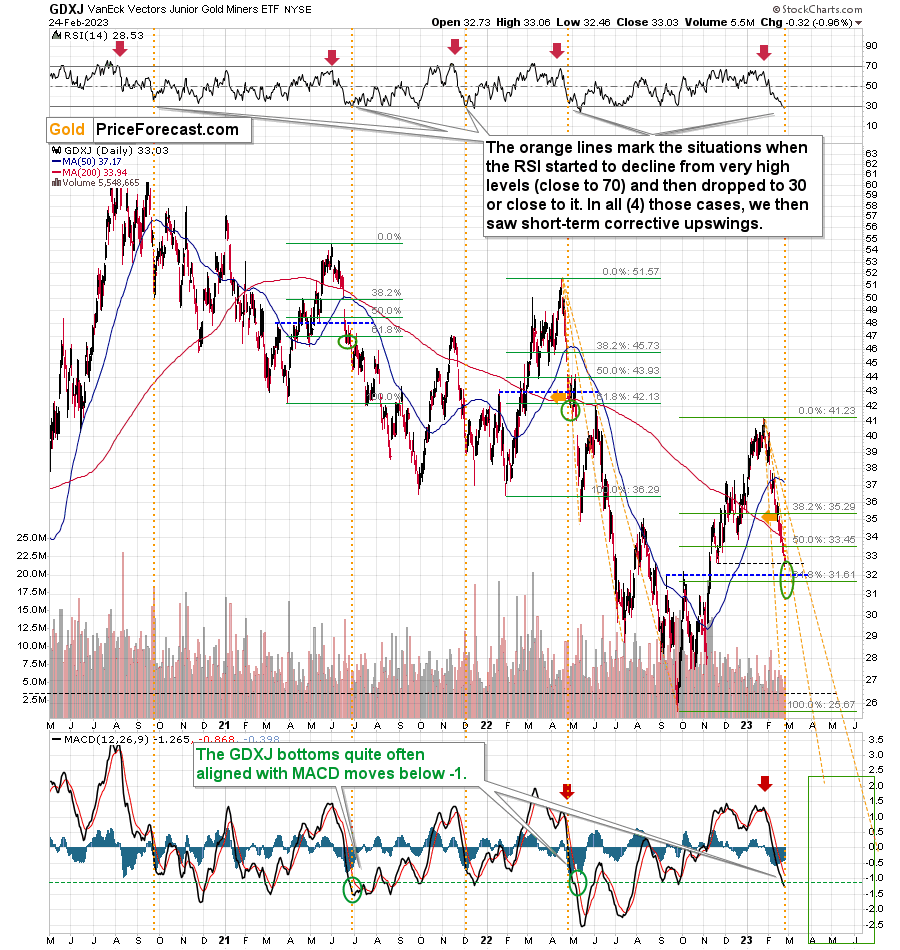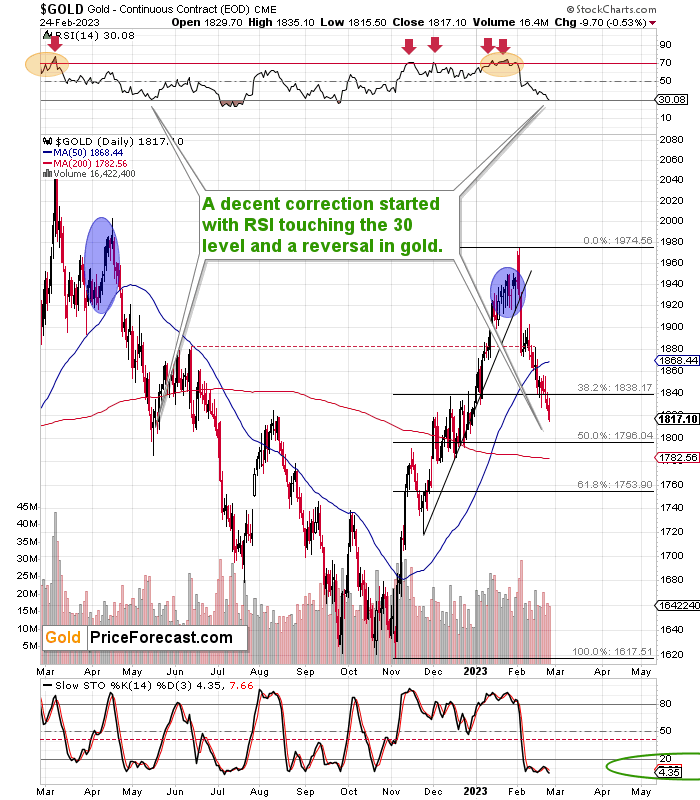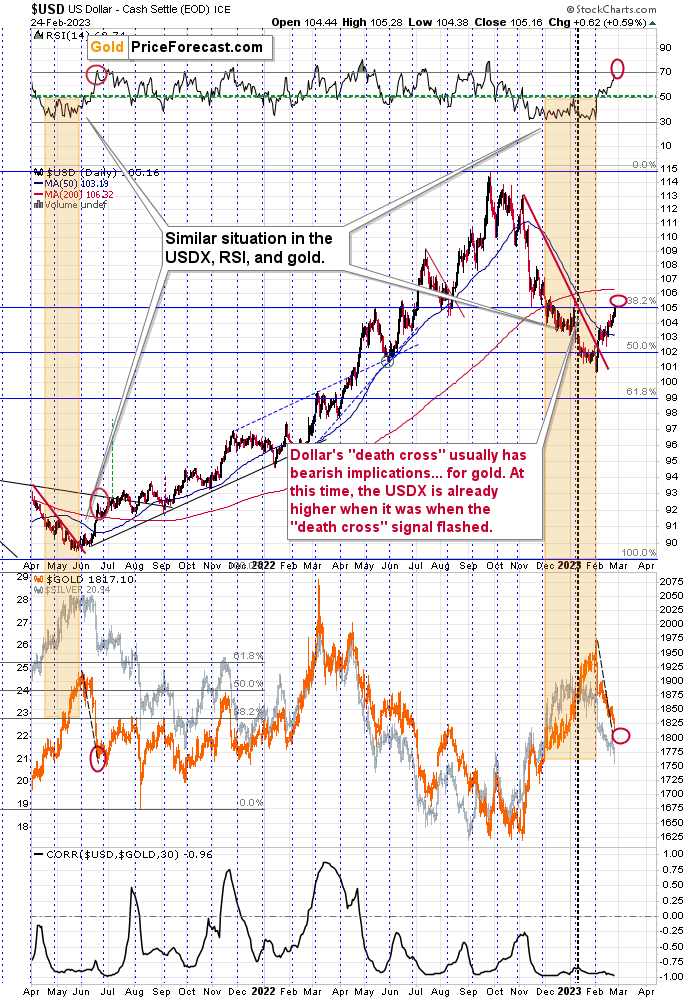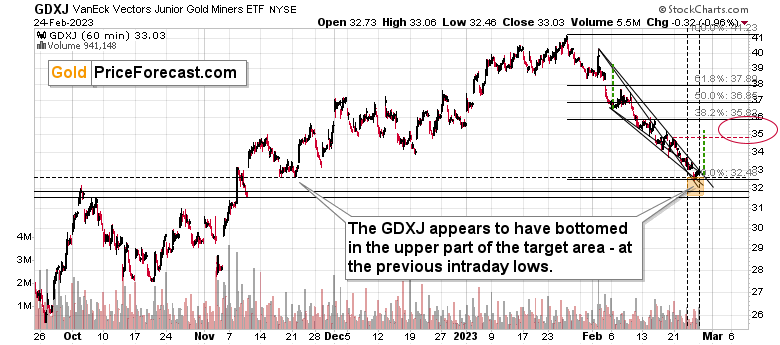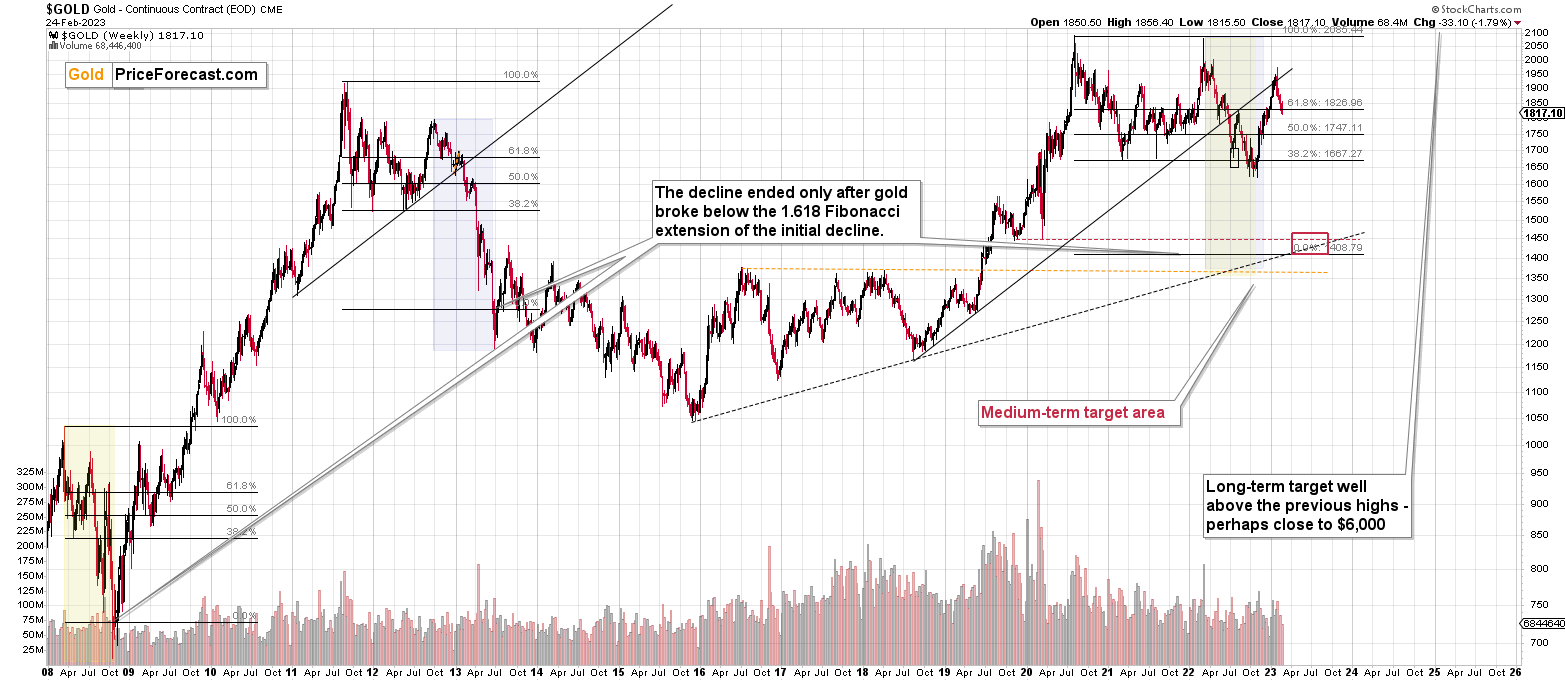Briefly: in our opinion, small (50% of the regular position size) speculative long positions in junior mining stocks are justified from the risk/reward point of view at the moment of publishing this Alert.
Good news, everyone! The long position in junior miners (GDXJ) that we entered right after taking profits from the previous short position became profitable practically immediately.
To be 100% precise, the GDXJ rallied by a little over 10 cents after the buy Alert, but still – that’s what happened. Given that the precious metals are no longer declining in today’s pre-market trading (in fact, the GDXJ is slightly up in today’s pre-market London trading even though the GDXJ did end the day in the red in the U.S. markets), it seems that we won’t have to wait for long for profits to increase. In fact, we might not need to wait at all.
Let’s take a look at the GDXJ’s chart for details.
The vertical orange lines mark the situations when the RSI started to decline from very high levels (close to 70) and then dropped to 30 or close to it. In all four of those cases, we then saw short-term corrective upswings. That happened in September 2020, June 2021, December 2021, and April 2022, and all these rallies materialized during a medium-term downswing, so these were the theoretically hard-to-catch rallies. This makes the performance of this indication quite impressive.
We saw the same indication on Friday.
Also, the MACD (lower part of the chart) moved below -1, which confirmed the start of the corrective upswings in two cases that are most similar to the current situation: June 2021 and April 2022.
You probably already heard or read that history tends to rhyme, but the similarity of those verses is truly uncanny!
Of course, indicators based on the GDXJ aren't the only thing that make the current short-term (!) picture bullish. It’s also the price level that the GDXJ reached. While it didn’t move to the Sep. and Oct. 2022 intraday highs nor the 61.8% Fibonacci retracement, it did move to the intraday November 2022 low and then moved back up before the end of the session. This means that the GDXJ has still moved to the upper border of my target area.
What about gold? Does the situation support higher prices in the near term?
Yes! While the price of the yellow metal itself didn’t reach any important support level – at first glance – the RSI based on gold’s price touched the 30 level. That's what meant local bottoms in the past, and also in May 2022, following a top and decline that are strikingly similar to the current situation.
Please keep in mind that I emphasized the fact that gold did not reach any significant support at first glance. In reality, gold approached the support provided by 2022’s closing price. Gold futures closed the previous year at $1,826.20, and yesterday’s move below that level was the first daily close below it this year. The previous day’s close was $1,826.80. So, if gold invalidates this breakdown (it wasn’t confirmed!) soon (today or tomorrow), we’ll have an invalidation of a breakdown, which will be a buy signal on its own.
Now, since miners tend to show strength before gold does, that seems quite likely to happen. In fact, please note that Friday’s session was when miners already showed strength compared to gold. The GDXJ reversed and moved back up before the end of the day, while the GLD ETF didn’t.
What about the USD Index, one of gold’s key drivers?
It has recently moved slightly above the 105 level and close to its previous 2023 highs. That high – in terms of the daily closing prices – was 104.83. The intraday 2023 high was 105.50, and the USD Index just moved between those levels. So, overall, one could say the previous 2023 high was approximately (!) reached.
This level serves as resistance, and it seems that it would be a good time for the USDX to pull back and prepare for another powerful move up. The RSI close to 70 clearly supports such an outcome as well.
On a final note, a pullback here would create the handle of a bullish cup-and-handle formation in the USD Index that would be a perfect launchpad for a medium-term upswing in the U.S. currency – and a powerful downswing in the precious metals sector.
However, is it 100% certain that the precious metals market has already bottomed?
No. There are no certainties in any market, and one had to be on the lookout for potential invalidations. Fortunately, there are precious-metals-market specifics that help one thrive even despite the uncertainty.
While the risk can never be completely eliminated (and nobody, myself included, can ever guarantee any sort of return), it’s true that around the bottom, mining stocks tend to show strength relative to gold.
This means that even if gold does move lower from here and bottoms close to $1,800, it’s not that likely to trigger a sizable move lower in the mining stocks – maybe something small, but nothing to write home about. Conversely, with just some strength in gold, gold stocks are likely to rally in a significant manner.
If you thought that was the end of the good news, I have a pleasant surprise for you.
After taking a look at the markets once more, it seems to me that the end of the easy part of the rally in the GDXJ is at higher levels than I previously thought – so the profit potential from the current long position appears to be bigger than we previously assumed.
It’s not visible from the broader perspective, but after zooming in, it’s clear that the GDXJ declined within a falling wedge pattern. Breakouts and breakdowns from this pattern are likely to be followed by moves that are just like the height of the wedge.
I marked it with a green, dashed line, and I copied it to the current situation. It points to a target above the $35 level.
That’s great, because there are a couple of very short-term price extremes there – local highs and lows. There’s also the 38.2% Fibonacci retracement level just below $36.
I marked the likely target area with a red ellipse. However, since the medium-term downtrend is likely extremely powerful (please read Friday’s extensive Gold Trading Alert for details), the risk – in my view – is to be outside of the short position, and in particular in a long position. Consequently, my focus will be to catch the easy part of the rally, take profits off the table, and re-enter the short position in order to capitalize on the enormous move lower.
So, the question is not when the rally is likely to end, but when the easy part of the rally is likely to end. In my opinion, the answer to that question is provided by the lowest of the above-mentioned target levels – the Feb. 17 intraday high. That’s $34.77. That day’s closing price was $34.59.
Now, since markets tend to view round numbers as important, this gets us to $34.50 as a potentially important level. Therefore, I’m placing the profit-take level for this long position a few cents below this level (at $34.47) – you will find details below the “Summary” paragraph.
And no, I’m not placing a stop-loss level at all, as my trades simply work better without them (in most cases, there are exceptions to this rule; I sometimes DO use them, usually to let the profits grow while ensuring that even if the trade goes sour, we’ll still come out ahead). I tested this over and over again, and that remains to be the case. It doesn’t mean that I’m letting the trade “run wild,” though. I’m simply focusing on more inputs than just the price of the asset when deciding whether to close a position or not. Of course, if you’d like to add a stop-loss level, feel free to do so – it’s your capital, and you can do with it as you see fit.
Either way, the upside potential for this likely quick trade appears bigger than it initially seemed, which also means that we’ll probably be able to get back to the short position at even higher levels, thus increasing profits on the short side as well.
Overview of the Upcoming Part of the Decline
- It seems to me that the big corrective upswing is over, and we’ll see just a small correction before the decline really picks up.
- If we see a situation where miners slide in a meaningful and volatile way while silver doesn’t (it just declines moderately), I plan to – once again – switch from short positions in miners to short positions in silver. At this time, it’s too early to say at what price levels this could take place and if we get this kind of opportunity at all – perhaps with gold prices close to $1,500 - $1,550.
- I plan to switch from the short positions in junior mining stocks or silver (whichever I’ll have at that moment) to long positions in junior mining stocks when gold / mining stocks move to their 2020 lows (approximately). While I’m probably not going to write about it at this stage yet, this is when some investors might consider getting back in with their long-term investing capital (or perhaps 1/3 or 1/2 thereof).
- I plan to return to short positions in junior mining stocks after a rebound – and the rebound could take gold from about $1,450 to about $1,550, and it could take the GDXJ from about $20 to about $24. In other words, I’m currently planning to go long when GDXJ is close to $20 (which might take place when gold is close to $1,450), and I’m planning to exit this long position and re-enter the short position once we see a corrective rally to $24 in the GDXJ (which might take place when gold is close to $1,550).
- I plan to exit all remaining short positions once gold shows substantial strength relative to the USD Index while the latter is still rallying. This may be the case with gold prices close to $1,400 and GDXJ close to $15 . This moment (when gold performs very strongly against the rallying USD and miners are strong relative to gold after its substantial decline) is likely to be the best entry point for long-term investments, in my view. This can also happen with gold close to $1,400, but at the moment it’s too early to say with certainty.
- The above is based on the information available today, and it might change in the following days/weeks.
You will find my general overview of the outlook for gold on the chart below:
Please note that the above timing details are relatively broad and “for general overview only” – so that you know more or less what I think and how volatile I think the moves are likely to be – on an approximate basis. These time targets are not binding nor clear enough for me to think that they should be used for purchasing options, warrants, or similar instruments.
Letters to the Editor
Please post your questions in the comments feed below the articles if they are about issues raised within the article (or in recent issues), and if they are about other, more universal matters, I encourage you to use the Ask the Community space (I’m also part of the community, after all), so that more people can contribute to the reply and then enjoy the answer. Of course, let’s keep the target-related discussions in the Gold Trading Alerts space.
Summary
To summarize, while the precious metals sector is likely to move much lower in the following months, it seems likely that we’re seeing a short-term corrective upswing right now, similar to the ones on which we profited in 2022 (as a reminder, we went long on May 12, took profits on May 26, and we went long between Jul. 11 and Jul. 18 and took profits on Jul. 28).
As a reminder, since the medium-term downtrends are so strong, I’m not aiming to catch the perfect top but rather to catch the easy part of the rally, cash profits, and get back on the short side once that easy part of the rally is over. Missing the huge move might be costly in terms of missed profits.
From a medium-term point of view, real interest rates are up and about to soar higher, the USD Index has most likely bottomed and is likely to soar, while the precious metals topped in a spectacular manner and are now likely to slide – either shortly or soon enough.
What’s likely to happen after the corrective upswing? Something exciting (and, in my view, very lucrative) or something scary – depending on how positioned and informed one chooses to be.
Also, please note that (paraphrasing Sun Tzu) “understanding the enemy without understanding your true self is only half of a victory.” Before applying any insights into actionable practice (and placing or adding to your trades), please make sure that the position that you’re about to enter and its size are aligned with your approach, your investment goals, and your risk tolerance.
In other words, I suggest starting with yourself, and tailoring the trade to you, not the other way around. Please consider your motivation for this trade and how it aligns with the rest of your approach and life in general.
Hint: don’t go for the easy answer like “money” or “profits,” but consider why the result of the trade is important – is this a part of your well-designed strategy and “you have it,” or is it something you “must absolutely do” – in other words, “it has you”…).
This will save you lots of stress, which is not only end in and of itself (your happiness and health are both closely linked to your stress levels), but it also helps you become a more profitable investor as less stress (or none thereof) means more objectivity and less risk of “running for the hills” right before a given trade becomes profitable (perhaps extremely so).
Given the above, gold’s invalidation of the temporary move above its very long-term resistance (the 2011 high!), and the situation in the USD Index, it seems that the next big move lower in the precious metals sector is already underway.
Now, as more investors realize that interest rates will have to rise sooner than expected, the prices of precious metals and mining stocks (as well as other stocks) are likely to fall. In my opinion, the current trading position is going to become profitable in the following weeks, and quite possibly in the following days. While I can’t promise any kind of performance, I fully expect it to become very profitable before it’s over and to prolong our 2022 winning streak.
After the final sell-off (that takes gold to about $1,350-$1,500), I expect the precious metals to rally significantly. The final part of the decline might take as little as 1-5 weeks, so it's important to stay alert to any changes.
As always, we'll keep you – our subscribers – informed.
To summarize:
Trading capital (supplementary part of the portfolio; our opinion): Full speculative short positions (300% of the full position) in junior mining stocks are justified from the risk to reward point of view with the following binding exit profit-take price levels:
Mining stocks (price levels for the GDXJ ETF): binding profit-take exit price: $34.47; stop-loss: none (the volatility is too big to justify a stop-loss order in case of this particular trade)
Alternatively, if one seeks leverage, we’re providing the binding profit-take levels for the JNUG (2x leveraged). The binding profit-take level for the JNUG: $32.77; stop-loss for the JNUG: none (the volatility is too big to justify a SL order in case of this particular trade).
For-your-information targets (our opinion; we continue to think that mining stocks are the preferred way of taking advantage of the upcoming price move, but if for whatever reason one wants / has to use silver or gold for this trade, we are providing the details anyway.):
Silver futures profit-take exit price: $21.97
SLV profit-take exit price: $20.17
AGQ profit-take exit price: $26.34
Gold futures profit-take exit price: $1,857
HGU.TO – alternative (Canadian) 2x leveraged gold stocks ETF – the upside profit-take exit price: $12.67
HZU.TO – alternative (Canadian) 2x leveraged silver ETF – the upside profit-take exit price: $19.57
Long-term capital (core part of the portfolio; our opinion): No positions (in other words: cash)
Insurance capital (core part of the portfolio; our opinion): Full position
Whether you’ve already subscribed or not, we encourage you to find out how to make the most of our alerts and read our replies to the most common alert-and-gold-trading-related-questions.
Please note that we describe the situation for the day that the alert is posted in the trading section. In other words, if we are writing about a speculative position, it means that it was up-to-date on the day it was posted. We are also featuring the initial target prices to help you decide whether keeping a position on a given day is in tune with your approach (some moves are too small for medium-term traders, and some might appear too big for day-traders).
Additionally, you might want to read why our stop-loss orders are usually relatively far from the current price.
Please note that a full position doesn't mean using all of the capital for a given trade. You will find details on our thoughts on gold portfolio structuring in the Key Insights section on our website.
As a reminder, "initial target price" means exactly that: an "initial" one. It's not a price level at which we suggest closing positions. If this becomes the case (as it did in the previous trade), we will refer to these levels as levels of exit orders (exactly as we've done previously). Stop-loss levels, however, are naturally not "initial,” but something that, in our opinion, might be entered as an order.
Since it is impossible to synchronize target prices and stop-loss levels for all the ETFs and ETNs with the main markets that we provide these levels for (gold, silver and mining stocks - the GDX ETF), the stop-loss levels and target prices for other ETNs and ETF (among other: UGL, GLL, AGQ, ZSL, NUGT, DUST, JNUG, JDST) are provided as supplementary, and not as "final". This means that if a stop-loss or a target level is reached for any of the "additional instruments" (GLL for instance), but not for the "main instrument" (gold in this case), we will view positions in both gold and GLL as still open and the stop-loss for GLL would have to be moved lower. On the other hand, if gold moves to a stop-loss level but GLL doesn't, then we will view both positions (in gold and GLL) as closed. In other words, since it's not possible to be 100% certain that each related instrument moves to a given level when the underlying instrument does, we can't provide levels that would be binding. The levels that we do provide are our best estimate of the levels that will correspond to the levels in the underlying assets, but it will be the underlying assets that one will need to focus on regarding the signs pointing to closing a given position or keeping it open. We might adjust the levels in the "additional instruments" without adjusting the levels in the "main instruments", which will simply mean that we have improved our estimation of these levels, not that we changed our outlook on the markets. We are already working on a tool that would update these levels daily for the most popular ETFs, ETNs and individual mining stocks.
Our preferred ways to invest in and to trade gold along with the reasoning can be found in the how to buy gold section. Furthermore, our preferred ETFs and ETNs can be found in our Gold & Silver ETF Ranking.
As a reminder, Gold & Silver Trading Alerts are posted before or on each trading day (we usually post them before the opening bell, but we don't promise doing that each day). If there's anything urgent, we will send you an additional small alert before posting the main one.
Thank you.
Przemyslaw K. Radomski, CFA
Founder, Editor-in-chief


